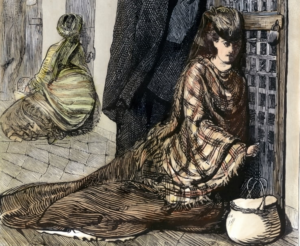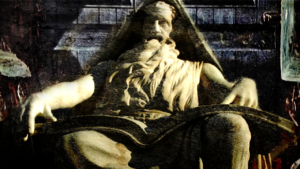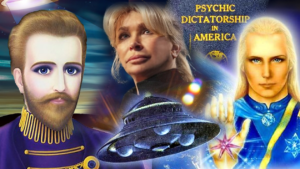Primer on the Reality of The Immaterial

This article is a relatively drawn out series of propositions intended to be a ‘from basics’ primer for belief in the immaterial. It endeavours to leverage reason and observation for the purpose of deducing the strong case for there being immateriality, and that this immaterial existence encapsulates the entirety of the material realm, and to find that it is not only possible, but necessary in order for reality to be coherently understood. I hope it may serve as a helpful guide.
If one wishes to provide feedback or to ask questions, please message me on my Twitter account at @Apotheiite.
FIRST, we need to establish our epistemology:
1. I am subject to experiences outside myself; therefore, I must be a real thing that can be acted upon by other things.
2. My experiences must relate to some extent to a reality, as only things that are real could inform me of my own reality and act upon me as a real thing.
3. The substance of my thoughts must pertain to real things, as my thoughts are constituted upon experiences, which I know must be to some extent real.
4. Thus any knowledge I make from thinking upon my experiences must, to some degree, relate to those experiences as they really exist, because the grounds for my relation with them is necessarily upon what is real of them, and not what is false.
5. As my thoughts pertain to things as they really are, at least to some degree, the conclusions I draw about them must be real conclusions, relating to real things as they really are, that are accurate of them to the degree that I holistically understand them.
SECOND, knowing that we can think of and know reality, we can draw conclusions from it:
1. I know from observation that nothing in reality can contradict, thus there are no real (or true) contradictions.
2. If there are no real contradictions, there can be no real (or true) opposites. Anything seeming to be an opposite, i.e., water and fire, light and dark, are only thought to be opposites, but are not really opposites.
E.g.: Water is not the negation of fire, the addition of water to a woodfire only produces a new chemical reaction, which results in the cessation of the fire. There are also forms of fire that are not negated by water, but instead water antagonises the fire. Thus, they are not opposites. Light also does not negate darkness as its opposite, but rather darkness is merely the state of any place without light. Darkness is not a ‘thing’ to be negated, but an absence. After investigation, every perceived opposite is similarly found to be not real. Belief that opposites are real is derived from true observations of real things; but, due to some ignorance, these observations were led by the mind towards false conclusions.
3. If there are no real opposites, then all things must in some way be congenial with one another, for nothing can negate another, only alter.
4. This common congeniality between all things means all things must in some way relate to one another, for if they did not relate to one another in some way, there could be no basis for their congeniality; there could also be no basis for one thing to alter or impact another thing if there is no relation between them.
5. Further, any real thing can alter, impact, or interact with any other real thing in accord with how they relate, thus all things must be related.
6. The universal common relation between all real things is reality (i.e., being real), thus all real things participate in a common relation of reality, giving them a fundamental unity (which we name ‘reality’).
7. It is right to say that this fundamental unity within which all real things are participants is what gives all real things their common congeniality, for it is upon the mutual relation that every real thing has with every other real thing that universal congeniality is established, and the unity of reality is really the totality of these common relations taken together. Thus, the unity of reality gives all real things their congeniality and unifies them.
8a. If the unity of reality did not give all real things their congeniality, then real things would have no way to have relations with one another as there would be no common grounds upon which to have relations, thus real things would not be capable of altering, impacting, or interacting with other real things.
8b. So much so that it would be impossible to call another thing ‘real’ if the unity of reality did not give congeniality, as we know the basis for knowing real things is upon our experiences and the conclusions we draw from them, and our experiences require a relation between ourselves and that which we experience, thus requiring ourselves and the real thing we experience to participate in a common, fundamental unity of reality.
8c. Further, if the unity of reality does not give congeniality, we would be incapable of having certainty in the reality of ourselves, as our only way of knowing ourselves to be real is by our experiencing real things that act upon us a real thing within a field of real things. If we reject that our experiences are the product of mutual relations we have with other real things, we have no grounds to believe we are real.
9. The conclusion that we are not certainly real is self-defeating, for if we are not real, then we cannot know what reality is, thus we cannot make a judgement of whether we are not we are real. Further, if we were not real, we would have no concept of reality, so we could not even ask the question if we are real. Thus, we must be real, as asking the question itself is precedented upon our reality.
10. As such, it is certain that reality is an encompassing and total unity that gives to all real things congeniality with one another, and is the grounds for every relation between real things, for we know the alternative is impossible.
THIRD, we having now concluded the unity of reality is necessarily real and not merely a construct of the mind, we move forward to what this means:
1. All real things are united and congenial with all other real things, but we observe some things are more congenial with one another than others.
2a. Those things that are more congenial are observed to be more ‘in likeness’ to one another, sharing similarities in their nature. For example, apple trees and apples are more congenial to one another than an apple is to other fruit trees, or apple trees to other fruits. This is observed by fact that only apple trees produce apples, and only from the seeds of apples can apple trees be grown. A pear tree cannot grow apples, and apple seeds cannot grow pear trees.
2b. It is recognised that an individual apple is a distinct and separate thing from an individual apple tree, and that an apple is distinct from all other apples, and that an apple tree is distinct from all other apple trees. Thus, all these things are mutually distinct. Further, e.g., an apple is also mutually distinct from all other real things upon the same basis that it is mutually distinct from other apples and from apple trees, thus the relation of mutual distinction is no different or unique.
2c. But despite this, an apple is more congenial with other apples in a real manner, because in spite of one apple’s mutual distinction from all other apples, which is a relation it has with all other real things, an apple has familiarity with all other apples a common likeness of nature. This real likeness is observed in the common traits all apples have, the common form they take, and the common activity they engage in.
2d. Thus, real distinctions between real things does not preclude those real things from having unity with one another–the truth of this we had actually concluded just earlier via different reasoning.
3. It is observed apples are more like one another than they are like other things, and as we established the fundamental unity of reality is the totality of the relations that connect all things, likewise the unity of apples is the totality of the unique relations that connect all apples. While the unity of reality does not preclude anything, the unity of apples necessarily precludes all non-apple things, as the totality of relations between apples are unique solely to apples.
4. Although the totality of relations between all apples is unique to the unity of apples, there are some relations between apples that are not unique to the apple-unity, but are not as universal as the unity of reality. All apples have a certain degree of likeness with all other fruits in a form of likeness all fruits share with all other fruits. E.g., although apples are more like apples than they are like pears, apples and pears are more alike to one another than either of them are in like to dogs.
5. Thus apples, pears, and any other vegetation that shares in likeness to apples and pears the nature of being a fruit all partake in a real unity of fruit. The unity of fruit encapsulates the totality of the mutual relations all fruits uniquely have with all other fruits, and we must say that the unity of fruit itself is the grounds for the mutual relation of fruits, as according to the same reasoning we gave prior for the unity of reality being the grounds for all relations and it giving all things their congeniality.
6a. We are now capable of extrapolating from the reasoning just given the reality of other unities without need for any further extensive explanation, as the criterion for a real unity remains the same no matter what is being considered.
6b. The cause for why the criterion remains constant is because every unity that can be considered is a derivative of the first unity, the unity of reality, and necessarily participates within this first unity, as the first unity encapsulates the totality of all relations, and every real unity is known by the relations between the things that participate within it, so the unity of reality must contain all types of relations, thus containing all things.
7. We may then deduce that there is, for example, a unity of life, a unity of animals, a unity of vegetation, a unity of elements, a unity of atoms, a unity of stars, a unity of galaxies, a unity of planets, a unity of solar systems, etc. All these unities are real unities, they exist as realities, and their constitution is the totality of all the things that cohere in, or participate within, them.
FOURTH, recognising that there exist real unities within the unity of reality containing things of common likeness, we must inquire as to why, and by what means:
1. We know every apple participates in a real ‘Apple-Unity’, which we deduce to be so by observation of the likeness apples share with one another. Apples, however, do not spontaneously come into existence, thus the likeness they share in common is not accidental.
2. Apples of the unity of apples participate within that unity due to their common origin in apple trees. Apple trees produce apples that participate in the unity of apples because they themselves participate in a unity of apple trees that share in likeness the activity of producing apples.
3. The apple tree does not participate within the unity of apples itself, as an apple and an apple tree are quite different, yet it must in some way “contain” the unity of apples within itself for it is the progenitor of apples, and for something to be the progenitor of another thing, it must in some sense “know” the model of that which it intends to produce. Ergo an apple tree, by some unknown mode, possesses an innate “knowledge” of the unity of apples within itself, upon which it models its activity of producing apples.
4. Likewise, it is only from the seeds of apples that an apple tree grows and comes to be. It would be incorrect to say that an apple seed is an apple tree, for not all apple seeds become apple trees, and apple seeds are clearly quite distinct and different from apple trees. Yet, as it is from apple seeds that apple trees grow, an apple’s seeds must also, by still some unknown mode, possess an innate “knowledge” of the unity of apple trees within itself, upon which it also models its own activity of becoming an apple tree.
5. Here we observe a cycle of motion (i.e., change), where an apple tree produces an apple according to its innate knowledge of apples, and the apple produced contains seeds that possess an innate knowledge of apple trees, and from these seeds grows an apple tree as according to their innate knowledge of apple trees, and from these new trees the cycle continues with their production of apples.
6. This cycle conjoins these different yet related things into one greater, more holistic unity. This greater unity encapsulates the entirety of the apple plant’s life, activity, and existence. Although throughout the cycle there are significant changes in the form and activity of the things involved, there is a persistent chain of continuity. This chain of continuity is their *essence*. It is in sharing this common essence that apple seeds, apple trees, and apples all participate in their common greater unity, despite their particular differences.
7. Because the essence participates directly in the greater union and is not partial like the smaller unities, it contains within it every form of the apple cycle, i.e., it contains within it the tree, the fruit, and the seed. It is by virtue of this continuity of essence that the tree has the capacity to produce the fruit and with it the seed, and the seed the capacity to produce the tree.
8. Now, it might be argued that what has been called ‘essence’ here is in fact DNA, and that DNA contains the “innate knowledge” prior referred to, and it is from DNA that a tree derives its model for producing apples and seeds their model for producing trees. This is partially correct in the sense that genetic code exists as a materialised analogy or ‘mirror’ of the essence within living things.
9. However, genetic code is limited only to the living, whereas we began our approach to unities from the unity of reality, which contains both living and non-living things. For our theory to stand up to reason, all the aforementioned regarding apples must also be found to be true in things that are not living, and if it is found to be true, then we can be safe in inferring the same among the living as we already have done.
10. Accounting for essence being responsible for the continuity of likeness between things of a common unity, thus being that which informs the form and activity of a thing, for it is by this informing of a thing that it retains the continuity of likeness to other things it shares its essence in common with, should there be a unifying essence be present within non-living things, we would expect it to be key to the retention of a continuity of likeness between non-living things and other non-living things they share a union of likeness with.
11. As atoms and molecules are the constituents of everything material and are in themselves non-living, it would be reasonable to extrapolate any conclusions made regarding them to the larger compounds they constitute. Let us consider the oxygen atom as our model. Privileged by modern science, we know by our empirical observations that from one oxygen atom to another, there is not only common likeness, but rather more extremely, there is complete *identicality*. The same is true for every atom type, every atom being completely identical to every other atom of the same type.
12. Furthermore, due to their identicality, every oxygen atom behaves identically the same as every other oxygen atom. The conjunction of two oxygen atoms always produces only two allotropes (i.e., molecular oxygen or singlet oxygen), the allotropes themselves also completely identical to all other allotropes of the same atomic structure, and the conjunction of two hydrogen atoms with one oxygen always produces a water molecule. As much is true for every atom and every atomic structure.
13. As to what we owe such consistency, it might be argued that an atom’s subatomic constituents mechanically informs the atom’s behaviour and provides it this perfect consistency. However, this does not resolve the question: we find among the subatomic particles the same dilemma as we found among the atoms, with every subatomic particle having perfect identicality with every other individual of its kind. Should we be tempted to push the search for a material mechanical cause even further and suppose there be an even more fundamental particle that constitutes the subatomic particle that we have yet to discover, we still are met with the same dilemma.
14. If we pursue this line of thought to its end, we will either 1) continue ad infinitum and theorise there be an infinity of potentially “more fundamental” particles, which in truth is fantastical in its suggestion, unproven, and unlikely within the confines of a finite universe that we understand began with a uniform singularity; or 2) conclude that there is one most fundamental and original particle that is the constituent of all things after it and from it the mechanical character of everything is derived.
15. Rejecting conclusion 1) out of hand due to its infinite absurdity, we consider conclusion 2): if it is true, which it conceivably may well be, then it demands of us an even more mystical explanation, for now we must answer how it is that from the total uniformity of this single most primordial and fundamental particle the significant complexity of things came after it. If the earliest particle is of only one kind and every bit of matter was originally this particle, then every change this particle has undergone must have been self-imposed. However, since every particle must be identical—for if they were not identical, then we would be forced to look for another more fundamental particle—then they must be mechanically identical, and so there could not be any unique combinations among the primordial particles, but rather every particle would only act identically the same. Yet, it is self-evident they did not remain the same, as from them the whole variety and differentiated complexity of the world has come to be.
16. Being left with no way of mechanically explaining how a uniformly same field of identical particles managed to produce from it entirely different and unique forms, we are compelled to search for a theory that would explain and enable this process. This theory we have already proposed: this fundamental and earliest particle that formed the constitution of the universe in its primordiality could be conceived to drive itself towards the generation of unique and novel particles from itself only if it possessed an essence as according to our theory, whereby this essence contained within it the totality of all potential material constructs—just as the greater apple unity contains the totality of all potential ‘apple constructs’— and it is by the essence containing this that it was capable of driving what was first a uniform sea of undifferentiated identicality into a grand complex multitude of differentiated and unique things.
17. Accepting this, we will find that it immediately coheres with our existing conclusions. This most primordial essence responsible for giving rise to the whole order of material things has via all those things an essential continuity, and it is upon its essential continuity within all things that the unity of reality is established. In other words, the congeniality of all real things we prior established and derived knowledge of the unity of reality from is owed directly to the fact all real things partake in and are derived the same primordial essence.
FIFTH, at last having established the primacy of essence in informing the character of unities, and acknowledging the formative role it has in producing and maintaining those unities, we come to inquiring what this ‘essence’ truly is:
1. We prior acknowledged that it cannot be thought possible for a uniform and identical series of things to produce after itself and from itself alone a distinct multitude of unique and different things, as the uniformity and identicality of the first thing would mean anything it could possibly produce must be the only thing that could ever be produced from it, since there exists no other substance or material that could be used to create a different outcome. So, in order for something more to come of this uniformity, something that is intrinsic to it, and yet not subject to the same constraints as it, is required to influence it.
2. We have suggested that it is its “essence”, that by the essence it has potential to produce more complex forms from its own base material that does not in itself possess them. We cannot say that this essence subject to the material substance itself, because if it were, then it would necessarily be forced to the restraints suffered by the material. Since the essence is definitionally not bound by those restraints, it must be immaterial.
3. But we have also said that it is intrinsic to the material, since there has not been – so to speak – any of this primordial material “left behind”, i.e., all of matter has adopted for itself some kind of distinct form with its own distinct nature and structure. Thus, essence as a formative influence must be intrinsic to all of it, because the entirety of all material things have received form.
4. Therefore, the essence must be both immaterial so that it is free of the restraints imposed upon material substances, and yet it must be intrinsic to all material things because all material things possess some kind of form and no longer exist as primordial matter, so it would be right to say then that all material things partake within this essence, for no placed is found without it.
5. But is the essence only intrinsically with the matter, or can it extend beyond the matter? Since the primary attribute this essence has as it relates to the matter it is tied with is that it is not constrained by the boundaries of the material, then necessarily we’ve ought to say that the immaterial essence may exist beyond the material, but no material may exist beyond the immaterial essence.
6. If it is argued that perhaps in some unknown part of the universe, or in an entirely different universe, there could conceivably be material beyond the immaterial essence, our answer is that it is impossible to make true conclusions about the reality we know and can observe from considering the possible scenarios in other realities we do not know and cannot observe. It is unwise for a man to deny the observations he makes and to deny the knowledge he knows for the sake of a theoretical scenario where the conclusions he drew from reality would be proven false. So, this sort of question is not worthy of consideration or investigation until empirical evidence is given and forces us to reconsider the conclusions we’ve drawn about the world.
THUS, to conclude our lengthy search here for now, we have come to a principle upon which we can build our metaphysics.
From observation, it is only natural for us to deduce the reality of there being an immaterial essence that provides the form, nature, and motion of material things, and that things cannot be reducible to their simplest material principles as primordial material simplicity negates the potential for the universe’s complexity of form. We find that this immaterial essence, to which all material is intimately conjoined and shaped by and reliant upon for their identity and relationships with all other things, must be present in a omnipresent manner throughout the whole cosmos.
In deducing this, we have found the beginning of the whole divine order of souls, daemons, and gods, of whom form the basis for our reality and are responsible for everything that fills it. To avoid making this article any longer than it already is, we won’t cover any further investigation into the natures of the immaterial essences, but I pray this article serves enough of a primer to warrant further investigation and to consider taking them seriously.
Fiat.











